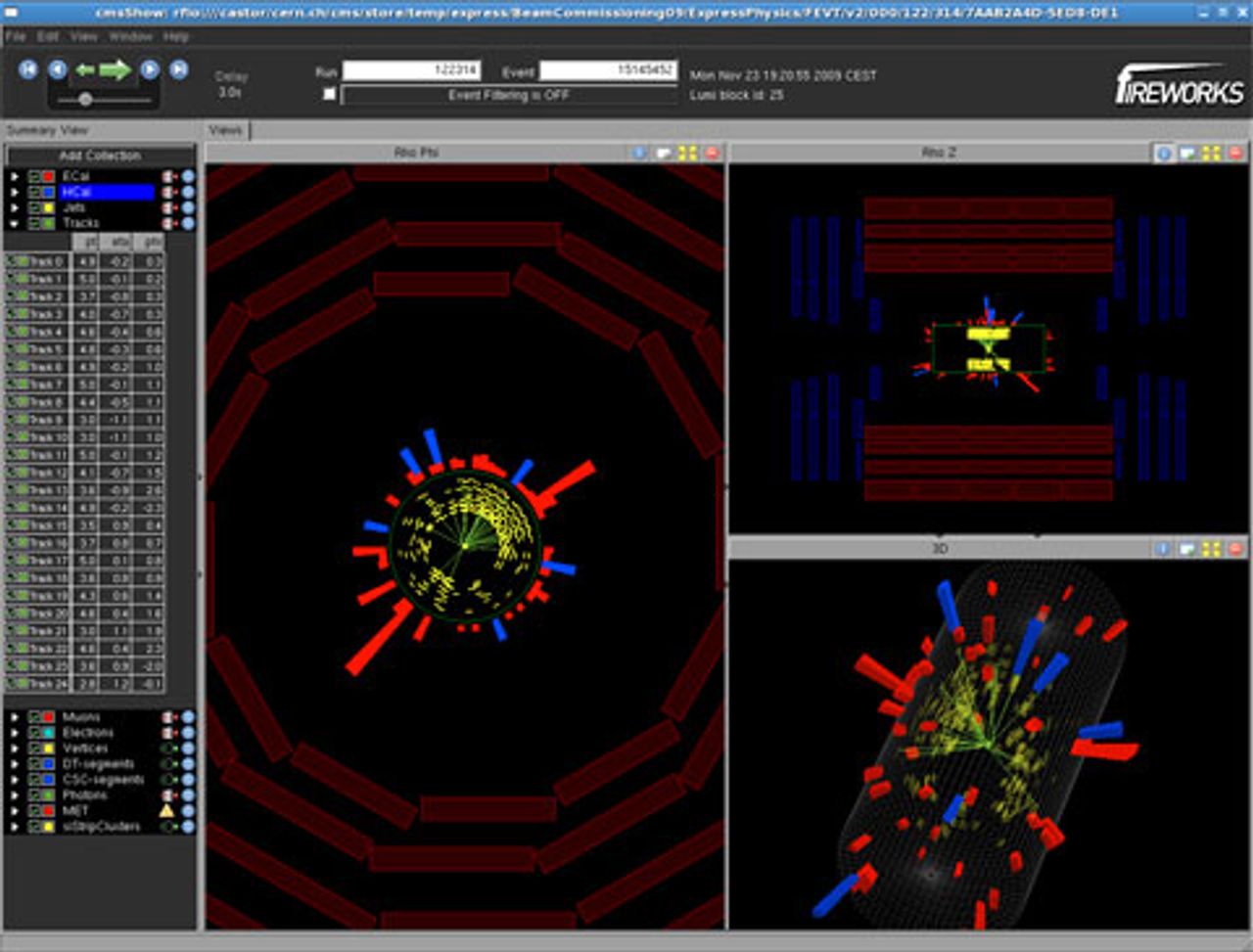This month marks the resumption of operations at the Large Hadron Collider (LHC), the huge new experimental device operated by the European Organization for Nuclear Research (CERN) in Switzerland. The largest and costliest apparatus ever built to conduct physical research, the LHC was shut down for repairs for a year after an accident.
The LHC is to resume low-power operation early this week (February 22-24), and is scheduled to run at half-power sometime in March. CERN engineers decided last month at a meeting in Chamonix, France, to limit the collider to half power, about 3.5 trillion electron volts (TeV) for the next 18 to 24 months.
The LHC operated for less than a month last year, from November 23 to December 20, as part of the process of recovery from the accident that occurred September 19, 2008. A slightly misaligned magnet caused the LHC beam to vaporize six tons of liquid helium coolant, causing an explosion inside the detector.
During the experimental re-start, the two beams of the LHC were centered and stable. Each beam was operating at 900 gigaelectronvolts (GeV), or about 13% of the full energy. At these energies, the first confirmed collisions of the LHC were found.
 The figure shows an event display of the Central Muon Solenoid (CMS), one of the four main detectors of the LHC. At the center of the display is the collision itself, in which the two beams of protons crash into each other, creating new particles the physicists attempt to detect.
The figure shows an event display of the Central Muon Solenoid (CMS), one of the four main detectors of the LHC. At the center of the display is the collision itself, in which the two beams of protons crash into each other, creating new particles the physicists attempt to detect.
Once this reconstruction is complete, the event is ready for physicists to study.
The primary goal of the LHC is to expand what is known as the Standard Model of particle physics. Akin to chemistry’s Periodic Table, the Standard Model is the sum total knowledge of every known particle. However, as with the Periodic Table in the 1800s, there are holes that need to be filled. This leads into the search for the Higgs boson.
In the 1960s, Peter Ware Higgs gave a proposal that suggested there was a broken symmetry in the electroweak theory, which comprises electromagnetism and nuclear forces, but not gravitation, indicating there is a fundamental particle that gives particles mass. This came to be known as the Higgs boson, and one of the main questions the LHC hopes to answer. Does the Higgs boson exist, or does the Standard Model need to be reworked?
The existence of the Higgs boson would indicate what is called a Higgs field, which would extend all through space, and give particles their individual masses. If this is so, it would explain certain oddities in the Standard Model, such as why the top quark is 171 GeV in mass, more than 40 times that of the next most massive particle, the bottom quark.
To detect particles, the Large Hadron Collider employs the principle of Conservation of Energy. Each collision has a certain amount of energy, the maximum being the total energy of the two beams added together. During the collision, all sorts of particles are created and decay, some of which we detect, but many we will not. Some, such as the neutrino, we know exist and will be created, but we know they will not be detected. Such particles go undetected, but not unnoticed.
This failure to detect is what physicists look for. A red flag goes up during a collision in which there is a massive particle detected going off in one direction, but nothing is seen in the opposing direction. This is known as the missing transverse energy (MET), and a key element in the search for new particles. It indicates something new that we can't currently detect, but with the given MET, physicists are able to narrow down the possible characteristics of the particle considerably. This is the heart of detector physics.
After ramping up each beam to 900 GeV, on November 29, 2009, the LHC set the world record for maximum collider energies by increasing the energy of each beam to 1180 GeV, or approximately 1.2 teraelectronvolts (TeV). This means a potential 2.4 TeV for each collision, 0.4 TeV above the previous record set by the Fermi National Accelerator Laboratory (Fermilab) set in Chicago, Illinois. Despite this, Fermilab still remains the leader in discoveries, as, for now, the LHC is still in its ramping-up phase, where much of the focus is the proper operation of the detector, not making new physical discoveries.
The 2010 LHC run will involve additional ramping up of the Large Hadron Collider. Each beam will operate at 3.5 TeV, half of the maximum energy, to ensure that further problems are dealt with appropriately, avoiding the disaster that happened in September, 2008.
Despite the large amount of technical difficulties the LHC is facing, it is expected to be fully operational by 2011. At maximum energy, the LHC will operate at total collision energy of 14 TeV (7 TeV for each beam). These energies are needed to approximate the energies seen a trillionth of a second after the Big Bang. It is at these energies that exotic particles, those that don't currently exist in nature, can be recreated.
